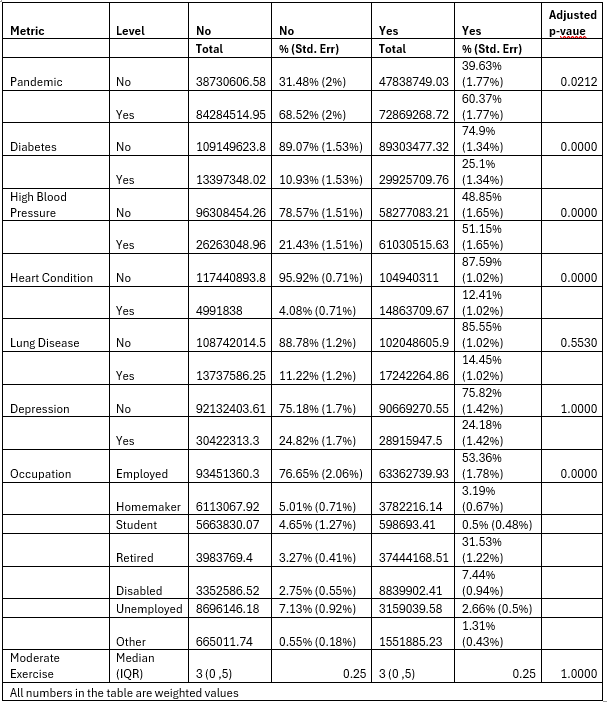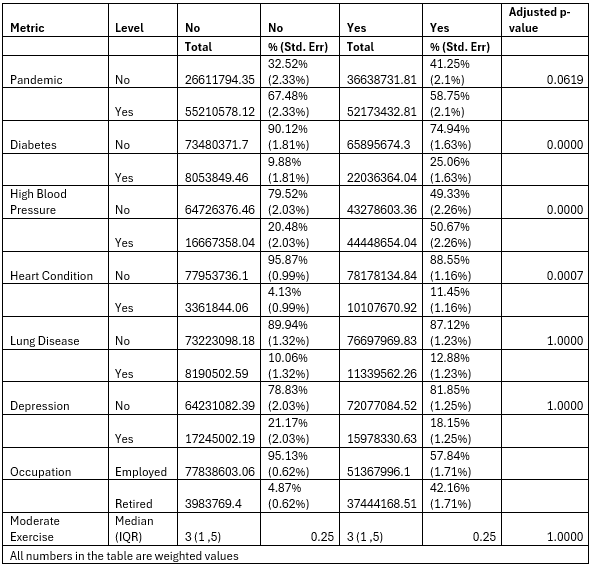Tuesday Poster Session
Category: Colorectal Cancer Prevention
P4747 - Colorectal Cancer (CRC) Screening in Active and Retired Workers in the United States of America: An Analysis of the COVID-19 Pandemic, Comorbidities, and Physical Activity Impact
Tuesday, October 28, 2025
10:30 AM - 4:00 PM PDT
Location: Exhibit Hall

Oladoyin Jolaoye, MD, DO
OSF Saint Francis Medical Center
Peoria, IL
Presenting Author(s)
Oladoyin Jolaoye, MD, DO, Rooma Nankani, MD, Sonu Dhillon, MD
OSF Saint Francis Medical Center, Peoria, IL
Introduction: During the COVID-19 pandemic, various medical and physical activities were disrupted because of the enacted lockdown. In this study, we examined the impact of the pandemic, comorbidities, and physical activities on the colorectal cancer (CRC) screening rate in the United States (U.S.) among active and retired U.S workers.
Methods: We performed a cross-sectional study using data from the National Cancer Institute National Trends Survey (HINTS 5), cycle 4. We used the Chi-square test to evaluate the association between CRC screening, comorbidities, and physical activity in the general population, active, and retired workers. Frequency, percentage, and standard errors were calculated for all categorical variables. Median, interquartile range, and standard errors are presented for numeric variables. Weighted values, according to HINTS 5 Cycle 4, were reported. All analyses were performed in R (R Core Team, 2022) and assumed a two-sided, 5% level of significance. P-values were adjusted for multiple hypothesis testing using a Bonferroni correction.
Results: In the dataset, there were 147,216,623 employed households, compared to 51,002,444 that were retired. In the general population shown in Table 1, the odds of being screened for CRC were lower during the pandemic (P < 0.05), and the odds of screening for CRC were higher in individuals with diabetes and a heart condition (P < 0.05). The odds of being screened for CRC did not differ in those with a lung disease or suffering from depression (P > 0.05). There was no association between moderate exercise and being screened for CRC. In the subpopulation of active and retired workers shown in Table 2, there was no longer an association between the pandemic and CRC screening (P > 0.05), and no association between moderate exercise and being screened for CRC (P > 0.05). The Odds of being screened for CRC were not affected by active and retired workers with lung disease or depression (P > 0.05). The odds of CRC screening in active and retired workers were higher in individuals with diabetes or a heart condition (P < 0.05).
Discussion: The odds of being screened in the general population were lower during the pandemic, a reason was that in-person diagnostic methods were stopped, postponed, or greatly reduced during the pandemic. Non-invasive screening methods should be encouraged and easily accessible in conjunction with telehealth. Screening kits can be mailed to the places of residence of individuals when there is a lockdown.

Figure: Table 1: Summary of the COVID-19 Pandemic, Physical Activity, and Comorbidities on CRC screening in the general population.

Figure: Table 2: Summary of the COVID-19 Pandemic, Physical Activity, and Comorbidities on Colorectal Cancer Screening in Active and Retired Workers
Disclosures:
Oladoyin Jolaoye indicated no relevant financial relationships.
Rooma Nankani indicated no relevant financial relationships.
Sonu Dhillon indicated no relevant financial relationships.
Oladoyin Jolaoye, MD, DO, Rooma Nankani, MD, Sonu Dhillon, MD. P4747 - Colorectal Cancer (CRC) Screening in Active and Retired Workers in the United States of America: An Analysis of the COVID-19 Pandemic, Comorbidities, and Physical Activity Impact, ACG 2025 Annual Scientific Meeting Abstracts. Phoenix, AZ: American College of Gastroenterology.
OSF Saint Francis Medical Center, Peoria, IL
Introduction: During the COVID-19 pandemic, various medical and physical activities were disrupted because of the enacted lockdown. In this study, we examined the impact of the pandemic, comorbidities, and physical activities on the colorectal cancer (CRC) screening rate in the United States (U.S.) among active and retired U.S workers.
Methods: We performed a cross-sectional study using data from the National Cancer Institute National Trends Survey (HINTS 5), cycle 4. We used the Chi-square test to evaluate the association between CRC screening, comorbidities, and physical activity in the general population, active, and retired workers. Frequency, percentage, and standard errors were calculated for all categorical variables. Median, interquartile range, and standard errors are presented for numeric variables. Weighted values, according to HINTS 5 Cycle 4, were reported. All analyses were performed in R (R Core Team, 2022) and assumed a two-sided, 5% level of significance. P-values were adjusted for multiple hypothesis testing using a Bonferroni correction.
Results: In the dataset, there were 147,216,623 employed households, compared to 51,002,444 that were retired. In the general population shown in Table 1, the odds of being screened for CRC were lower during the pandemic (P < 0.05), and the odds of screening for CRC were higher in individuals with diabetes and a heart condition (P < 0.05). The odds of being screened for CRC did not differ in those with a lung disease or suffering from depression (P > 0.05). There was no association between moderate exercise and being screened for CRC. In the subpopulation of active and retired workers shown in Table 2, there was no longer an association between the pandemic and CRC screening (P > 0.05), and no association between moderate exercise and being screened for CRC (P > 0.05). The Odds of being screened for CRC were not affected by active and retired workers with lung disease or depression (P > 0.05). The odds of CRC screening in active and retired workers were higher in individuals with diabetes or a heart condition (P < 0.05).
Discussion: The odds of being screened in the general population were lower during the pandemic, a reason was that in-person diagnostic methods were stopped, postponed, or greatly reduced during the pandemic. Non-invasive screening methods should be encouraged and easily accessible in conjunction with telehealth. Screening kits can be mailed to the places of residence of individuals when there is a lockdown.

Figure: Table 1: Summary of the COVID-19 Pandemic, Physical Activity, and Comorbidities on CRC screening in the general population.

Figure: Table 2: Summary of the COVID-19 Pandemic, Physical Activity, and Comorbidities on Colorectal Cancer Screening in Active and Retired Workers
Disclosures:
Oladoyin Jolaoye indicated no relevant financial relationships.
Rooma Nankani indicated no relevant financial relationships.
Sonu Dhillon indicated no relevant financial relationships.
Oladoyin Jolaoye, MD, DO, Rooma Nankani, MD, Sonu Dhillon, MD. P4747 - Colorectal Cancer (CRC) Screening in Active and Retired Workers in the United States of America: An Analysis of the COVID-19 Pandemic, Comorbidities, and Physical Activity Impact, ACG 2025 Annual Scientific Meeting Abstracts. Phoenix, AZ: American College of Gastroenterology.
